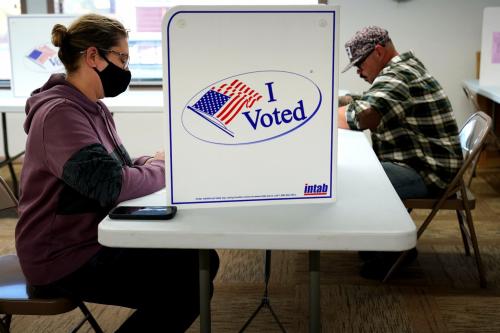Most federal managers have now finished the most meaningless task of their year: rating their employees using a nearly useless performance appraisal system. If the past is any guide, their subordinates were not only all above average, they were just about outstanding. Lake Wobegon has nothing on Washington.
The hyperinflation in the performance appraisal process is hard to miss. Measured on a 5-point scale, the average federal employee moved up from 4.05 in 1991 to 4.2 in 1996, the last year that governmentwide data are available. That number is well above “fully successful,” just above “exceeds fully successful,” and well on the way to “outstanding.”
The inflation is even more visible in the percentages of employees in each of the five categories—nonacceptable, minimally successful, fully successful, exceeds fully successful and outstanding. As of 1996, only 0.3 percent of federal employees were rated minimally successful, and just 0.07 percent as nonacceptable. So much for the Office of Personnel Management’s widely publicized claim in February that only 3.7 percent of federal employees are poor performers. According to the actual performance ratings, the true number of poor performers is 15 times smaller than OPM’s estimate.
Not all employees are doing equally well. As of 1996, 56 percent of mid-level managers were rated outstanding, compared to 49 percent of mid-level non-managers, and 39 percent of lower-level employees. But everyone has been getting better since 1991, when just 35 percent of mid-level managers, 32 percent of mid-level non-managers, and 27 percent of lower-level employees were outstanding. If past trends hold true, every last federal employee will be rated outstanding by 2010.
To be fair, the ratings could have gone down in 1997 and 1998. Then again, Lake Wobegon’s Chatterbox Cafe might be real. OPM has stopped publishing the ratings data in its Fact Book. One reason is that OPM cannot decide how to count the ratings from the pass/fail systems that now cover one out of 10 employees.
If OPM counts a “pass” as fully successful, which any good teacher would do, the overall ratings would go down, giving reinventing government another black eye to match the one delivered in August when the General Accounting Office questioned the effort’s budget savings. But if OPM counts a pass as outstanding, the ratings would rise faster than a powder milk biscuit on a hot summer day. Better not to issue the data at all, it seems.
The lack of recent data is not the reason Vice President Al Gore will not be talking about the ratings this year, however. He knows the data are wrong. Federal employees may be good, they may be highly motivated, and they most certainly are doing more with less. But the very definition of “outstanding” demands comparison. If the term is to have merit, it cannot apply to more than a handful.
Gore also knows the hyperinflation is another sign that the federal personnel system is teetering on collapse. Managers long ago gave up on the performance appraisal. Scholars long ago proved that 80 percent of subordinates think they are in the top 20 percent of performers. To do their jobs well, federal managers would have to confront at least three-quarters of their subordinates with the hard truth. That takes both guts and grace. And for what? A grain of financial gain? A trip to the grievance office?
Federal managers are not the problem, however. Congress and the President have known for years that the performance appraisal system is broken and have done nothing to fix it. Gore offered a glimpse of reform last January, but Clinton could not spare even a sentence on the idea in his egregiously overstuffed, 82-item State of the Union laundry list the very next week.
Even if Gore’s notion that pay should somehow be linked to customer satisfaction were to emerge from the stalemate between organized labor and OPM, managers will continue to over-grade employees until the following four things happen:
- Deflate the system. The number of outstanding ratings must be capped well below the current level. If the purpose of appraisals is to increase performance, the target must keep rising.
- Involve real money. Until the bonus pools increase, managers have ample reason to shirk those tough choices and rotate the award programs.
- Abolish most pass/fail systems. High performers should be rewarded with bigger sums, poor performers should be tossed out, and satisfactory performers should be allowed to do their jobs in peace.
- Reward teams and units, not just individuals. It could well be that 80 percent of employees are in the top 20 percent of performers if they are part of high-performing groups that deliver the goods and services as a unit, rather than as a collection of independent actors.
For the time being, however, the ratings are best taken as a symptom of failure, not success. They create the fictional image of a federal government where all the women are strong, all the men are good-looking, and all the children are above average. Under the current performance appraisal system, that is a federal government that can only exist in Lake Wobegon East.


Commentary
Behold Lake Wobegon East
October 1, 1999